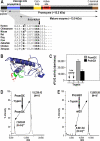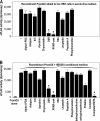Group X secreted phospholipase A2 proenzyme is matured by a furin-like proprotein convertase and releases arachidonic acid inside of human HEK293 cells
- PMID: 21878635
- PMCID: PMC3196088
- DOI: 10.1074/jbc.M111.268540
Group X secreted phospholipase A2 proenzyme is matured by a furin-like proprotein convertase and releases arachidonic acid inside of human HEK293 cells
Abstract
Among mammalian secreted phospholipases A(2) (sPLA(2)s), group X sPLA(2) has the most potent hydrolyzing activity toward phosphatidylcholine and is involved in arachidonic acid (AA) release. Group X sPLA(2) is produced as a proenzyme and contains a short propeptide of 11 amino acids ending with a dibasic motif, suggesting cleavage by proprotein convertases. Although the removal of this propeptide is clearly required for enzymatic activity, the cellular location and the protease(s) involved in proenzyme conversion are unknown. Here we have analyzed the maturation of group X sPLA(2) in HEK293 cells, which have been extensively used to analyze sPLA(2)-induced AA release. Using recombinant mouse (PromGX) and human (ProhGX) proenzymes; HEK293 cells transfected with cDNAs coding for full-length ProhGX, PromGX, and propeptide mutants; and various permeable and non-permeable sPLA(2) inhibitors and protease inhibitors, we demonstrate that group X sPLA(2) is mainly converted intracellularly and releases AA before externalization from the cell. Most strikingly, the exogenous proenzyme does not elicit AA release, whereas the transfected proenzyme does elicit AA release in a way insensitive to non-permeable sPLA(2) inhibitors. In transfected cells, a permeable proprotein convertase inhibitor, but not a non-permeable one, prevents group X sPLA(2) maturation and partially blocks AA release. Mutations at the dibasic motif of the propeptide indicate that the last basic residue is required and sufficient for efficient maturation and AA release. All together, these results argue for the intracellular maturation of group X proenzyme in HEK293 cells by a furin-like proprotein convertase, leading to intracellular release of AA during secretion.
Figures






References
-
- Schaloske R. H., Dennis E. A. (2006) Biochim. Biophys. Acta 1761, 1246–1259 - PubMed
-
- Lambeau G., Gelb M. H. (2008) Annu. Rev. Biochem. 77, 495–520 - PubMed
-
- Singer A. G., Ghomashchi F., Le Calvez C., Bollinger J., Bezzine S., Rouault M., Sadilek M., Nguyen E., Lazdunski M., Lambeau G., Gelb M. H. (2002) J. Biol. Chem. 277, 48535–48549 - PubMed
-
- Murakami M., Taketomi Y., Girard C., Yamamoto K., Lambeau G. (2010) Biochimie 92, 561–582 - PubMed
-
- Funk C. D. (2001) Science 294, 1871–1875 - PubMed
Publication types
MeSH terms
Substances
Grants and funding
LinkOut - more resources
Full Text Sources

